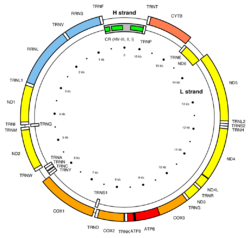Biology:MT-RNR1
Mitochondrially encoded 12S ribosomal RNA (often abbreviated as 12S or 12S rRNA) is the SSU rRNA of the mitochondrial ribosome. In humans, 12S is encoded by the MT-RNR1 gene and is 959 nucleotides long.[1][2][3] MT-RNR1 is one of the 37 genes contained in animal mitochondria genomes. Their 2 rRNA, 22 tRNA and 13 mRNA genes are very useful in phylogenetic studies, in particular the 12S and 16S rRNAs. The 12S rRNA is the mitochondrial homologue of the prokaryotic 16S and eukaryotic nuclear 18S ribosomal RNAs.[4] Mutations in the MT-RNR1 gene may be associated with hearing loss.[5] The rRNA gene also encodes a peptide MOTS-c, also known as Mitochondrial-derived peptide MOTS-c or Mitochondrial open reading frame of the 12S rRNA-c.
Structure
The MT-RNR1 gene is located on the p arm of the mitochondrial DNA at position 12 and it spans 953 base pairs.[6]
Function
The MT-RNR1 gene encodes for an rRNA responsible for regulating insulin sensitivity and metabolic homeostasis. The protein acts as an inhibitor of the folate cycle, thereby reducing de novo purine biosynthesis which leads to the accumulation of the de novo purine synthesis intermediate 5-aminoimidazole-4-carboxamide (AICAR) and the activation of the metabolic regulator 5'-AMP-activated protein kinase (AMPK). The protein also protects against age-dependent and diet-induced insulin resistance as well as diet-induced obesity.[3][2]
Clinical significance
Nonsyndromic Hearing Loss and Deafness, Mitochondrial
Pathogenic mutations in the MT-RNR1 gene have been found to cause late-onset Mitochondrial Nonsyndromic Hearing Loss and Deafness with predisposed aminoglycoside ototoxicities.[7] Nonsyndromic Deafness is characterized by a partial or total sensorineural hearing loss (SNHL) of variable onset and severity that is not associated with other signs and symptoms.[8] Most forms of nonsyndromic deafness are associated with permanent hearing loss caused by damage to structures in the inner ear.[2][3] Mutations of 1494C>T, 1555A>G, and 1095T>C in the MT-RNR1 gene have been identified to cause the hearing loss.[9][10][11]
Complex IV Deficiency
MT-RNR1 mutations have been associated with complex IV deficiency of the mitochondrial respiratory chain, also known as the cytochrome c oxidase deficiency. Cytochrome c oxidase deficiency is a rare genetic condition that can affect multiple parts of the body, including skeletal muscles, the heart, the brain, or the liver. Common clinical manifestations include myopathy, hypotonia, and encephalomyopathy, lactic acidosis, and hypertrophic cardiomyopathy.[12] A 9952G>A mutation was found in a patient with the deficiency.[13]
References
- ↑ "Sequence and organization of the human mitochondrial genome". Nature 290 (5806): 457–465. April 1981. doi:10.1038/290457a0. PMID 7219534. Bibcode: 1981Natur.290..457A.
- ↑ Jump up to: 2.0 2.1 2.2 "UniProt: the universal protein knowledgebase". Nucleic Acids Research 45 (D1): D158–D169. January 2017. doi:10.1093/nar/gkw1099. PMID 27899622.
- ↑ Jump up to: 3.0 3.1 3.2
"MT-RNR1 - Mitochondrial-derived peptide MOTS-c - Homo sapiens (Human) - MT-RNR1 gene & protein". https://www.uniprot.org/uniprot/A0A0C5B5G6.
 This article incorporates text available under the CC BY 4.0 license.
This article incorporates text available under the CC BY 4.0 license.
- ↑ "Distinctive sequence of human mitochondrial ribosomal RNA genes". Nature 286 (5772): 460–467. July 1980. doi:10.1038/286460a0. PMID 6157106. Bibcode: 1980Natur.286..460E.
- ↑ "Mitochondrial 12S rRNA gene mutations affect RNA secondary structure and lead to variable penetrance in hearing impairment". Biochemical and Biophysical Research Communications 341 (4): 950–957. March 2006. doi:10.1016/j.bbrc.2006.01.049. PMID 16458854.
- ↑ "MT-RNR1 mitochondrially encoded 12S RNA [Homo sapiens (human) - Gene - NCBI"] (in en). https://www.ncbi.nlm.nih.gov/gene/4549.
- ↑ Usami, Shin-ichi; Nishio, Shin-ya (1993). "Nonsyndromic Hearing Loss and Deafness, Mitochondrial". GeneReviews®. University of Washington, Seattle. https://www.ncbi.nlm.nih.gov/books/NBK1422/.
- ↑ Reference, Genetics Home. "Nonsyndromic hearing loss" (in en). https://ghr.nlm.nih.gov/condition/nonsyndromic-hearing-loss.
- ↑ "Molecular analysis of the mitochondrial 12S rRNA and tRNASer(UCN) genes in paediatric subjects with non-syndromic hearing loss". Journal of Medical Genetics 41 (8): 615–620. August 2004. doi:10.1136/jmg.2004.020230. PMID 15286157.
- ↑ "Maternally inherited aminoglycoside-induced and nonsyndromic deafness is associated with the novel C1494T mutation in the mitochondrial 12S rRNA gene in a large Chinese family". American Journal of Human Genetics 74 (1): 139–152. January 2004. doi:10.1086/381133. PMID 14681830.
- ↑ "A reappraisal of complete mtDNA variation in East Asian families with hearing impairment". Human Genetics 119 (5): 505–515. June 2006. doi:10.1007/s00439-006-0154-9. PMID 16528519.
- ↑ Reference, Genetics Home. "Cytochrome c oxidase deficiency" (in en). https://ghr.nlm.nih.gov/condition/cytochrome-c-oxidase-deficiency.
 This article incorporates text from this source, which is in the public domain.
This article incorporates text from this source, which is in the public domain.
- ↑ "Cytochrome c oxidase deficiency associated with the first stop-codon point mutation in human mtDNA". American Journal of Human Genetics 63 (1): 29–36. July 1998. doi:10.1086/301910. PMID 9634511.
External links
This article incorporates text from the United States National Library of Medicine, which is in the public domain.
 |


